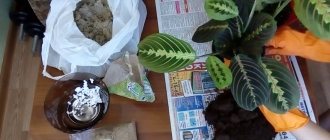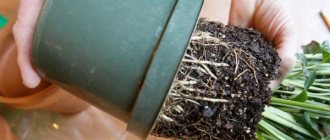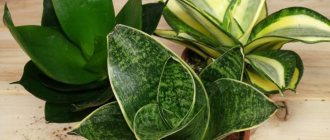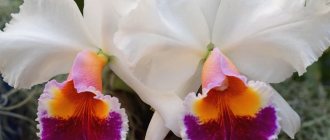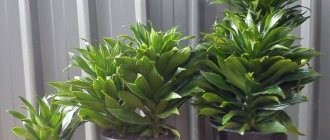The warm, humid forests of South and Central America are home to the beautiful Calathea. The ancient Greeks wove baskets from calathea leaves. But modern lovers of domesticated flora have appreciated the beauty of rich green painted plants from the arrowroot genus. This plant may lose its beauty or die completely if measures are not taken in a timely manner to treat diseases and destroy pests.
There are about 130 species of this large-leaved plant. And among them there are perhaps only a dozen who will feel truly comfortable at home.
Houseplant Calathea - description
From Latin the name “calathea” is translated as “basket”. This name is not because the indoor flower itself looks like a basket, but because of the leaf veins. They are dense and thick, so in ancient Greece they were actually used for weaving baskets.
Calathea belongs to the arrowroot family, and therefore, like all representatives of this family, it loves moisture very much. Perennial. Nowadays it is no longer used for weaving baskets, but is used for decorating rooms: it has large, beautiful leaves, and breeders have developed various varieties - with red leaves, pink leaves, pink veins and many other various decorations.
Calathea is beautiful, but rather capricious in terms of moisture levels. But it also has a positive feature: unlike many ornamental plants, it prefers shade rather than sun.
It is also known as the flower that raises its leaves at night. This is true: at night its leaves curl, and in the morning they bloom again. Because of this, she got the nickname “prayer flower”: as if he prays in the evenings and mornings.
What does calathea look like?
The plant is quite large, sometimes even resembling not a flower, but a tree: it reaches eighty centimeters in height, and the leaves are large, round, up to thirty centimeters in length. They grow in several stems-shoots from one rhizome.
The colors of the leaves can be very different, since there are many varieties of decorative calathea. Breeders also try to develop varieties with different patterns on the leaf blades, so two plants belonging to the same calathea species can look completely different.
Where it grows - the birthplace of the plant
Central and South America, shady, humid tropics.
How indoor calathea blooms
As with many plants whose main decorative value is their leaves, potential owners have the question “does calathea bloom or not at all?” Of course it blooms.
Flowering time: late spring, summer. The flowers are small, collected in small delicate spikelets, and come in pink, white, purple, orange and other colors.
Is Calathea poisonous or not?
It has poisonous juice. However, in Asian countries, the leaves of this plant are even used as plates, they wrap food in them, so calathea is absolutely safe - you are not going to chew the leaves to get juice from them. But you should not allow animals or children near the plant - they are not so prudent.
Why can a plant get sick?
If we talk about a houseplant called calathea, diseases and pests can appear on it only due to improper care. This is precisely what experienced flower lovers who successfully grow various varieties never cease to repeat.
Calathea is a perennial plant up to 1.5 m high
First of all, attention should be paid to watering. Excessive soil moisture, cold or hard water are factors that can negatively affect the quality of flower growth and development. After watering, there should be no drops left on the leaves of the plant, as this is not always beneficial.
The composition of the soil also plays a significant role. Oily and rotten soil can harm the growth of calathea. The cause of rotting is almost always excess liquid that is retained in the soil due to poor drainage. If moss, mold or fungus appears on the surface, they should be removed immediately.
Another name for calathea is prayer flower or praying grass.
The condition of the flower is also reflected in the correctly chosen pot. A small container will result in slower growth. A pot that is too wide and high also negatively affects the life of the plant.
Leaves can dry out due to lack of lighting or high temperature in the room. Moreover, each plant variety requires compliance with certain rules.
Fertilizers play a special role - they must be applied according to a certain schedule, in the proportions specified by the manufacturer. When using folk remedies as fertilizers, mineral complexes must be added in much smaller quantities.
Note! An overdose of nutrients is just as harmful as a deficiency.
How to care for Calathea at home
Caring for calathea is not too difficult; the most labor-intensive thing here is to provide the required level of humidity. Here are the factors you need to consider.
Replanting after purchase
Optional, but desirable, since it is unknown what is contained in store-bought soil (and it is usually scanty), and if you replant the flower, you will know for sure. Transplantation after purchase is no different from the usual one, described in the corresponding section below.
Please note that if a new pet blooms, it is better not to replant - flowering will immediately stop due to stress, so wait until it is finished. It is also better not to replant in winter, but to wait until at least early spring.
Lighting
Soft, diffused, partial shade desirable. Completely artificial lighting is not suitable; the calathea should receive sunlight, but only indirect light - it easily gets sunburned. If you put it on the balcony, be sure to block it from the sun with at least a curtain.
Temperature
The range of acceptable temperatures is quite wide: 16-24⁰С. Drafts and sudden changes in temperature (for example, suddenly opening a window in cold weather) are unacceptable; they lead to leaf rot.
Humidity
Very high is required, up to 90%. How to ensure this humidity:
- If you have a variety with glossy, smooth leaves, then wipe the flower every day with wet wipes, put it in the shower, and spray it (only warm water).
- If the variety has velvety, fleecy leaves, place the pot in a tray with wet pebbles (the pebbles should lie around, the bottom of the pot does not come into contact with them) and make sure that they are always wet. Be sure to wipe the leaves with a dry cloth to remove dust.
- Place in an aquarium or florarium.
- Keep away from heating devices. Calathea tolerates lack of light more easily than too dry air.
How to water a calathea
It is quite capricious regarding water quality and does not tolerate traces of lime. The water should be soft, ideally melt or rain. If it is not possible to water one, then the night before watering, you need to place peat wrapped in cloth in the water so that it disinfects and softens the water, and water it the next morning.
Do not let water drop on the leaves when watering, because if the wet leaves are then exposed to the sun, they will cause sunburn. Also, do not forget to drain the water from the pan to prevent rotting of the roots.
In summer
Two to three times a week.
in winter
Watering is reduced to once a week due to the fact that moisture evaporates more slowly.
Fertilizer and feeding
Feed from April to August, twice a month. Saffron calathea is fertilized with fertilizer for ornamental flower plants, and all other types - for plants with decorative foliage. There should be no nitrogen and calcium in the fertilizing. The dose of fertilizing is reduced by half from that indicated on the package.
How to resuscitate?
As a rule, it is possible to improve the health of Calathea as soon as a more suitable place is found. But we also don’t recommend moving the flower pot back and forth too often - for such a capricious plant it will be stressful, which will certainly lead to disease.
But it is more difficult to fight diseases or pests. It is better to use purchased drugs and not deviate one step from the manufacturer’s instructions.
Reproduction of calathea at home
Calathea can be propagated by cuttings (including leaves), dividing the bush or planting seeds. For the first three methods, you will need to perform a small surgical operation - to separate part of the plant. Therefore you will need:
- A sharp tool – scissors or a knife. They must be well sharpened, because you will need to separate part of the plant in one movement, without breaking or sawing, because such movements contribute to wounds that take longer to heal, accordingly, your pet is more vulnerable during this period.
- Alcohol or a saturated solution of potassium permanganate to disinfect instruments before surgery.
- Also, to disinfect the sections, you will need crushed activated carbon - you will sprinkle it on the sections.
- The cuts are made obliquely (at an angle of 45 degrees) - these are easier for the plant to heal and grow a new shoot in its place.
- Gloves to avoid getting your hands dirty with soil.
- Containers for small plants or one large container for seeds. For starters, just plastic cups filled with a special mixture for young plants (which will be discussed below) are suitable.
- Polyethylene or glass, because calathea is, in principle, a moisture-loving plant, and especially its seedlings.
It is best to propagate in the spring, so that the seedlings have favorable summer conditions for formation, and the mother plant calmly survives the stress of such manipulations. So, let's take a closer look at each method of propagating calathea at home.
Leaf
What needs to be done: cut a leaf from the calathea (healthy, large, whole, without damage, elastic) and plant it in a separate small pot with moist soil, cover with a greenhouse.
The greenhouse is removed when the leaf gives its first roots. Before this, you need to check whether condensation remains on the glass or film - it needs to be removed with a cloth and the sheet ventilated. Please note that this is the most unreliable method, unlike, for example, succulents, calatheas are difficult to propagate by leaf.
Cuttings
The same as with a leaf, but instead of one leaf, a whole cutting is taken - a stem with several leaves from twelve centimeters.
Dividing the root
This method is much more reliable, since calathea itself is prone to forming several rhizomes, which can be easily divided into individual plants. Most often, propagation by division is carried out during transplantation.
What needs to be done: use a knife or scissors to separate part of the rhizome so that it is like its own separate plant with everything necessary for life - root, stem, leaves.
I plant this plant in a separate pot (nine centimeters in diameter, no more), filled with a mixture of sand and peat. These pots should be placed in a place where there is no sun, but it will be warm (about 20⁰C), watered abundantly and covered with polyethylene or glass. The next watering is carried out when the substrate dries.
When the first independent leaves appear on the cutting, it can be transplanted into a larger pot and cared for like an adult plant. Please note that this will not happen immediately; calathea takes a long time to take root.
Seeds
The method is unreliable, since often even freshly collected calathea seeds do not germinate. Therefore, try to plant more so that at least a few sprout.
What you need to do: fill the container with two parts of leaf soil and one part of sand and sow the seeds in them.
The container is placed in a warm place where the temperature is always around 25⁰C. The soil should always remain slightly moist and not dry out. The greenhouse above the container must be cleared of condensation and ventilated for 10 minutes a day.
When the seedling has the first pair of leaves, it can be transplanted into a separate small pot. Please note that most often plants grown in this way do not retain the characteristics of their variety.
How to plant a flower?
The optimal time for planting a flower is the off-season, autumn or spring. The action can be timed to coincide with the next Calathea transplant.
The plant is planted quite standardly: they carefully take out the bush along with the earthen lump, and slowly free the roots from the ground. Then the bush is divided into separate parts.
Important:
- So that each sprout has 2-3 leaves of its own.
- So that everyone has a well-developed rhizome.
Parts of a large bush are planted separately from each other. The soil requirements are standard (loose and nutritious), drainage should also be about a third of the height of the pot.
Calathea transplant at home
Planting calathea in a new pot is easy.
When to replant
The best time of year for replanting is early spring, when the calathea has recently emerged from hibernation, since a flowering or dormant pet may not be able to cope with the stress of moving to a new place.
Young (up to 3 years old) calathea must be replanted annually, and then once every two to three years. The main reason why a transplant may be required is that the pot has become “small”. This can be seen from the fact that the roots began to protrude from the ground - which means they have nowhere to grow.
Flowers are also replanted for sanitary purposes: for example, if you have over-watered and the plant has rotted (then it is often easier to replant than to wait for the soil to dry out), or if a fungus or pest has infested.
If transplantation is a measure of medical care, then it is carried out at any time of the year: it is more important to save the calathea than not to expose it to stress.
Priming
A slightly acidic soil that does not contain lime is suitable. This is, for example, the soil for azaleas and rhododendrons. You can also make the soil yourself.
So, what kind of soil is needed for planting calathea, what is the composition:
- You will need calcined river sand (it must first be placed in an oven heated to one hundred degrees for half an hour, and then left in a well-ventilated place for ten days so that beneficial microorganisms can grow there) - it will make up half of the soil mixture.
- The second half will be taken up by: leaf soil, humus, peat. As “vitamin supplements” you can put a little crushed coal (prevention against pests) or pieces of pine bark.
Pot
Small, since the root system of calathea usually does not grow too much. Each new pot is one third larger than the previous one (if the transplant is carried out for the reason “the previous pot has become small”). The material doesn't matter.
Action plan
- Prepare the pot and soil for replanting in advance. Also prepare a knife or scissors, because when replanting it is convenient to inspect the root system for rot and remove rotten parts.
To disinfect the sections you will need crushed activated carbon. You'll also probably need gloves to avoid getting soil on your hands.
- An hour before transplanting, water the calathea in an old pot generously - this will make it easier to get it out.
- Fill the new pot with a 2-3 cm layer of drainage. Sprinkle the drainage with a small layer of soil.
- An hour after watering, turn the pot over and carefully remove the calathea from it. Gently scrape the soil away from the roots or rinse them.
- Inspect for rotten (dark, brown or black) parts of the root system. If there is, it’s okay, just cut them off with a knife or scissors and sprinkle the sections with crushed activated carbon, and after that plant them in a new pot.
- Place the plant in the middle of the new pot. Holding with your hand so that it does not fall, fill in the remaining soil so that 1-1.5 cm of the pot remains empty (but keep in mind that after watering the soil will settle a little). Press the soil down, but not too tightly - the roots of the calathea need air, in this regard it is like an orchid.
- Water the plant immediately after transplanting and place it in the shade to allow it to adapt to the new conditions. The next watering is in 10 days. Done, landing was successful.
Where can I buy a plant?
You can buy calathea in offline and online flower shops. The cost ranges from 200 to 3 thousand rubles, depending on the type and size of the plant.
What to do immediately after buying a flower?
You need to accustom the plant to new conditions gradually; to do this, you need to place it for 2 weeks in a bright but shaded place where it is warm, there are no drafts or dampness.
After adaptation, the calathea must be replanted, completely replacing the soil and flowerpot, treated with Zircon using a spray bottle and watered generously.
Calathea diseases with photos and their treatment
As a rule, calathea diseases appear due to care errors, and treatment is to restore proper care.
The most common flower diseases:
- Root rot.
Causes: appears due to the fact that the plant is watered too often and abundantly.
Symptoms: the plant withers, dries out, turns yellow. It often becomes noticeable during transplantation, when examining the root system.
Treatment: if the lesion is small, then it is enough to stop watering for a while until the calathea absorbs the moisture that has already accumulated in the pot, and then restore it, but half as much as before, and gradually return to the normal watering regime.
- Drying of leaves.
| Probable Causes | What to do |
| Dry air. Calathea needs spraying or a tray with always damp expanded clay or pebbles, otherwise it dries out. | Remove dried leaves and restore the climate sufficiently humid for calathea. |
| Sunburn. Then the dried stain will be light brown in color and have vague outlines, indistinct. | Shade the plant, remove it away from the sun, and avoid direct sunlight. It will recover on its own, nothing else is needed. |
- Curling of leaves (during the day because it is normal at night, which is why Calathea is known as the flower that lifts its leaves at night).
| Probable Causes | What to do |
| Lack of watering or poor quality of water (cold, from the tap). | Water your home flower generously and never neglect watering again. |
| Draft or excessively cold (below eighteen degrees) climate. | Move to a warmer place without drafts. |
- Yellowing of leaves.
Possible reasons: too much or too little fertilizer.
What to do: analyze your behavior as an owner - have you overfed or underfed? And act accordingly: either feed or reduce fertilizer.
- Lack of flowering.
Probable reasons:
A) unsuitable soil. If you doubt your skills as a gardener, you can use weakly acidic, lime-free soil, ready for planting calathea in it, from the store.
B) any care errors. It’s difficult to say what exactly is wrong here. Flowers appear in any plant when it feels that conditions are favorable enough for reproduction (after all, by flowering, any plant, in fact, reproduces, prepares for reproduction), and anything, any deviation from the ideal can make it “think” differently.
Therefore, analyze your behavior, the conditions in which the calathea is kept (soil, pot, humidity level, frequency of fertilizing, how much there is around the world) and you will find an error.
Calathea sheds its leaves
Pests and diseases of Chlorophytum - causes and control
Calathea can shed its leaves for several reasons. Among the main ones:
- insufficient watering;
- the appearance of pests on the flower;
- improper lighting;
- cold.
First of all, you need to make sure that there are no parasites on the flower. To do this, you should carefully examine each leaf, soil and stem of the plant. Then it is necessary to adjust the care, in particular the temperature.
Pests of indoor calathea
Often the manifestations that calathea owners mistake for leaf diseases are actually symptoms that the plant has pests.
So, calathea pests:
- Spider mite.
Symptoms: a characteristic white coating, reminiscent of a thin cobweb, and white dots also appear on the indoor flower.
Why it appeared: Spider mites appear if the climate around them is dry enough. Therefore, the best prevention against it is frequent wet cleaning around the calathea and spraying.
What to do: if the lesion is small, then simply remove the leaves affected by the cobwebs. If the flower is significantly infected, there is a lot of plaque and insects, then you will need to treat the plant with several types of insecticides (the break between treatments is 10 days so that the chemicals do not negatively affect the calathea organism itself) and replant, because spider mites can lay larvae in the soil.
- Shield.
Symptoms: characteristic waxy spots on the leaves, and then, when the scale insect drinks enough juice, the plant withers, dries out, and becomes covered with brown spots.
What to do: wash off all insects from the calathea under a hot shower or using cotton pads generously soaked in a thick solution of laundry soap. Then start treating with insecticides.
The scale insect is dangerous because it easily adapts to chemicals thanks to its natural protection - a shield on its back - so you will have to arm yourself with several types of drugs at once, and also use cross-treatment with several of them at once.
- Thrips.
Symptoms: White spots on the leaves that will eventually dry out and become a hole.
What to do: treat with insecticides, replant the plant, reduce watering, since thrips often go hand in hand with root rot.
Why they appeared: unlike other pests, thrips prefer a humid climate, so they usually appear in waterlogged soil. Replanting is required: the soil dries out slowly, so thrips may appear again, even if you treated the calathea with medicines for them, because the conditions are favorable.
Prevention: sufficient (because calathea loves moisture), but not excessive watering.
What else you need to know about pests of indoor flowers:
- Most often, pests prefer dry climates, where they reproduce most actively. This is good news for you, because the very rules for keeping calathea mean that it needs to be moistened regularly; this is a flower that simply loves moisture. So, if you take care of the flower, dryness will not cause pests.
But it is still necessary to periodically inspect the calathea, look under the lower leaves (this is where insects often nest), especially when winter comes, the heating season begins, and the air becomes dry and hot from the radiators.
- Often pests are introduced simply because of bad luck. For example, they brought it from the street on shoes, or an insect jumped off a pet, or simply flew into a window. Therefore, do not blame yourself for “not looking”, this can happen to anyone. Calathea diseases often begin with improper care, but pests are pure luck.
- Pests are dangerous for two reasons: firstly, they are easy to miss and come to your senses when the insects have already multiplied so much that the plant cannot be saved, and secondly, they are very tenacious and easily adapt to the environment.
From here there are two conclusions: firstly, do not forget to periodically inspect your calathea in order to notice insects in time, and secondly, if they do appear, purchase several types of pest control medicines at once (usually fungicides and insecticides), because after the first they will not be lost during processing.
Answers to popular questions
Where to put the pot with Calathea?
It is best to place it on the floor, near the walls, away from radiators. You can place the flower on the windowsill (west, east or even south), but then you will have to protect it from direct sunlight.
When does the plant bloom?
This usually occurs in early spring and ends around early summer.
Can I leave it while on vacation?
Actually, no. Irregular watering, unstable humidity and temperature changes are the first step to disease and imperfect appearance.
Popular types of calathea: photos and names
The species differ in the appearance of leaves, patterns, and their number. You will find something to your liking.
Calathea Bachema
A species with rather lush foliage. The leaf blades are narrow, of a delicate light green hue, decorated with oblique “checkmarks”.
Calathea White Tiger or white fusion
A beautiful, unusual variety that looks like a careless sketch by a watercolor artist. An unusual combination of different shades of dark green with absolute whiteness - this flower looks like it was painted by an expressionist.
Kalathea Varshevich
The leaves are quite narrow, of a noble dark green hue, with thin, lighter veins. It blooms beautifully: the buds are white, resembling small roses.
Calathea Burle Marx
This variety differs from others in its sharper foliage: there is only one large, rounded foliage on each stem. The plate itself is a soft green shade with dark green frequent ticks.
Calathea Beauty Star
The rosette of this variety really resembles a rose of curving golden-green petals with a thick dark border around the edges and a dark green vein in the middle.
Calathea white star
A bit reminiscent of the White Tiger variety, but the leaves are larger and the rosette is more reminiscent of a star or rose. The leaves are white with thin dark green veins and edges.
Calathea vecha or vicha
This variety is distinguished by very large and beautiful leaves with an unusual pattern, reminiscent of the wings of a huge beautiful butterfly.
Calathea remarkable or lancifolia (lanceolate)
It is slightly reminiscent of aloe due to its narrow, elongated plates with a bizarre dark green on a golden green background pattern reminiscent of tiger stripes.
Calathea zebrina or striped
But this one doesn’t look very much like a zebra: a dark green plate, frequent light green veins, because of the bright contrast it feels like the foliage is glowing.
Calathea crocata or saffron
An unusual and beautiful variety with bright flowering. The flowers are bright orange, on thin, tall peduncles, and the leaves are dark green, almost black, with barely noticeable light veins. Great decoration for Halloween.
Calathea leopardina or leopardina
The foliage is quite abundant, with one leaf on a thin stem. The color is golden-green, light, with quite rare ticks of a darker shade.
Calathea litze
An unusual variety: the greenery here clearly shows a pink border, and the green itself is so dark that it seems almost black.
Calathea lubbersa
While other varieties have geometric patterns and ticks on the foliage, this large variety with large leaves has bizarre, unsystematic, and bright patterns.
Calathea makoya or makoyana
The plates are a delicate yellow-green shade with a bright pattern reminiscent of a twig with narrow dark leaves, with a dark border.
Calathea marion
A variety reminiscent of the feathers of a fairy-tale bird: rounded leaves, a light wide carved border, the core is dark green, and the leaf vein becomes lighter.
Calathea mosaic network
There are no geometric lines or ticks here - the veins here are thin and frequent, chaotic, as if millions of falling stars.
Calathea orbifolia
A variety reminiscent of the delicate leaves of water lilies: wide, rounded leaves with white-green stripes.
Calathea ornamented or ornate
Unusual variety: greens are dark to black, with graceful light stripes. An excellent decoration for a Gothic style interior.
Calathea ornata sanderina
The most popular variety of calathea is decorated.
Calathea pinstripe
The bright color of this variety resembles the skin of an exotic animal or even the comb of a dragon.
Calathea painted
Here the breeders achieved the absence of veins: the leaf is large, round, white in the middle, with a dark green border.
Calathea roseopicta
The same as the previous variety, but the middle of the plate is painted bright pink, even purple. Below are the most popular varieties of this variety.
Calathea roseopicta dotti
A variety with completely black leaves and thin pink veins in the middle and along the edge.
Calathea roseopicta illustris
Similar to the previous one, but a little lighter, not black, but dark green, but the pink border is wider.
Calathea roseopicta silvia
The plate is without veins, greenish-yellow, but the reverse is pale pink. There is a dark border along the edge.
Calathea roseopicta medallion
Representatives of this variety really resemble either a medallion in which an exotic topaz or opal is inserted, or a peacock feather.
Calathea roseopicta little princesses
An unusual variety: dark green plates with a torn pink, seemingly glowing purple border that does not reach the edge of the leaf.
Calathea rufibarba or redbeard
A variety similar to a fern, thanks to its narrow, upward shoots with ragged outlines and a light border along the edges.
Calathea silver
One of the lightest varieties with silvery-white narrow leaves and only thin, barely noticeable, dark green veins.
Calathea fasciata
The variety is distinguished by a warm, golden hue with rather rich and dark primary colors, reminiscent of the decoration of a fairy-tale castle somewhere in Italy.
Calathea flamestar
A variety with a bright, bizarre color: sharp strokes of veins in the middle and several layers of borders along the edges, because of which the plant seems to be on fire.
Calathea freddy
The variety is quite laconic compared to others, especially the previous one. Quite miniature, looks good on an office desk.
How to save calathea from diseases and pests
This indoor flower is affected by spider mites, scale insects, thrips, and fusarium wilt. This is often the result of improper plant care.
Table: methods of treating a flower from diseases and pests
| Disease or pest | Signs | Treatment |
| Spider mite | A white coating appears on the underside of the leaves, and over time, cobwebs appear. The tick itself is very small, it is almost impossible to see it. Affected leaves turn yellow and die. | The tick loves dry air, so the calathea must be sprayed. In addition, treatment is carried out with “Aktara” (2 g of the drug per 2.5 liters of water). |
| Shchitovka | Round brown plaques appear on the stems and leaf blades. The leaves lose color and dry out. | Wash off the scale insects with a solution of laundry soap and a soft cloth, then spray the plant with Fitoverm (1 ampoule per 1 liter of water). |
| Thrips | Discolored dots appear on the leaves, which eventually merge into solid spots. On the ground you can see small, elongated insects moving in jumps. | Rinse the plant well in the shower. Spray twice with Intavir (0.5 tablets per 5 liters of water). Water the soil in the pot with the same solution. |
| Sooty mushroom | Usually appears together with pests. The leaves and stems are covered with a dark coating, similar to soot. | To combat this disease, it is often enough to wash it off thoroughly with soap and water. |
| Fusarium wilt | Leaves and stems turn black and curl. Rot spreads upward from the roots, causing the plant to die. | Unfortunately, fusarium wilt of calathea cannot be treated. Plants are destroyed. |
Photo gallery: diseases and pests that affect calathea
Spider mites can be recognized by their webs and white coating on the leaves. Scale insects look like rounded plaques. Thrips leave discolored dots on the leaves. Fusarium wilt is very dangerous and cannot be treated.
Sooty fungus is a frequent companion of plant pests.
What does the Calathea prayer flower bring to the house: signs and superstitions
The popular names of calathea play on the theme of prayer: prayer flower, prayer flower, prayer flower, praying flower. Calathea curls its leaves in the evenings, and in the morning, when the sun rises, it straightens them again - hence its unusual name.
By the way, in fact, a prayer book is not a person who prays, but a book in which prayers are written.
Another name for calathea is also associated with religion: many varieties have exactly ten spots on the leaves, so the indoor flower began to be called the “ten commandments.”
Of course, a plant with such a halo in the mass consciousness must have various magical properties. Here they are:
- In general, Calathea has a very positive aura. It is believed that it helps people set goals, helps in reflection, in search of the meaning of life or simply the next step in a particular area. Moreover, achieving such goals becomes easy, as if the flower attracts good luck and helps resolve conflicts.
- It is believed that calathea helps you find yourself, a hobby in which your inclinations and skills will best reveal themselves.
- Also, reviews about the magical properties of the plant say that it helps restore health in older people.
By the way, this also has a more or less scientific basis: calathea has large, bright green leaves that purify the air, and when a person breathes fresh, clean air, his cardiovascular system improves, and therefore his overall well-being, because much in the human body depends on the work of the heart and lungs.
- Strengthens self-confidence and helps make family relationships more harmonious. This also applies to marital relationships.
- Calms children, helps them fall asleep more soundly and quickly, and helps them develop more easily and more actively.
- According to the Feng Shui system, calathea is a flower filled with solar energy Yang and under the auspices of Mars. Therefore, it also helps with health: it strengthens the cardiovascular system, drives away colds and even attracts wealth.
- They say that the prayer flower tree blooms when there is a seriously ill person in the house. Flowering, as it were, takes away the heavy, negative energy of the disease and helps the person recover. This distinguishes it from other plants: they dry out more often if they anticipate someone’s serious illness, as if foreshadowing trouble.
Whether to believe in all this is up to you to decide, but one way or another, calathea is a beautiful flower that is quite easy to care for and maintain; growing it at home does not cause much trouble, and it brings a lot of joy with its bright green appearance alone. Plus it really cleanses the air and calms the nerves by contemplating the beauty and calming green color.
Fertilizer and feeding
During the growing season (from early April to September), you need to apply fertilizers every 2 weeks, and in the fall and winter, if the plant is in satisfactory condition, reduce the number of fertilizing to once every 1.5-2 months or completely abandon them.
Suitable fertilizers are intended for plants of the Marantaceae family or universal fertilizers for decorative deciduous indoor flowers, for example, Bona Forte, Pokon, Agricola or Etisso.
Calathea reacts negatively to excess nitrogen and calcium; the content of these elements should be reduced.
Fertilizing should be done 10–15 minutes after watering; the plant should not be fertilized on dry soil.
Calathea in the interior: photo
What kind of pot do you need?
Calathea has a superficial root system that grows in breadth, so the pot needs to be low and wide, shaped like a bowl. Each new container should be 4–5 cm larger in diameter than the previous one.
The most suitable material is unglazed ceramics, which provides access to the required volume of oxygen to the roots.
The pot must have drainage holes, and during replanting it is necessary to lay a large layer of drainage on the bottom, which can be large pebbles, ceramic shards or expanded clay.
The trunk has wrinkled
The trunk is formed in adult calathas; it remains in place of dead old leaves. In a healthy plant, it is elastic and has the same color as the leaves. There should not be any yellow, black, brown, wet or sticky spots on it.
Shrinking of the trunk is a sign indicating the imminent death of the plant; it can be twisted at an unusual angle. This happens when most of the roots have rotted, and the above-ground part has stopped receiving nutrients and water. It is difficult to save such a badly damaged calathea. Usually, in this case, they cut off the top and root it, since the roots can no longer be saved.
What kind of soil is needed?
The soil for calathea should be moisture-permeable, nutritious, have good aeration and weak (pH 5.0–6.0) or neutral (pH 6.0–7.0) acidity.
You can use ready-made soil for arrowroot or azaleas, or prepare it yourself by mixing in equal parts:
- high peat;
- leaf soil;
- humus;
- coarse sand.
To deoxidize the resulting substrate, you need to add crushed charcoal to it at the rate of 40 grams per 1 kg of soil mixture.
The soil should not contain lime.
To get rid of pests, the soil mixture must be steamed in a water bath, poured with a weak solution of manganese, calcined in the oven, or treated with insecticides and fungicides, such as Aktara, Aktellik or Fundazol.
